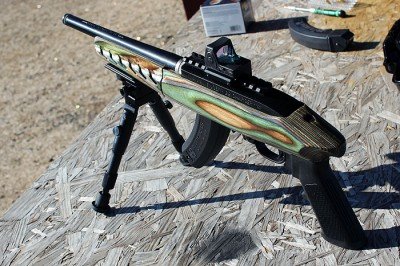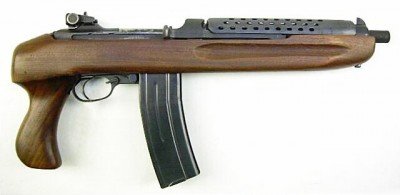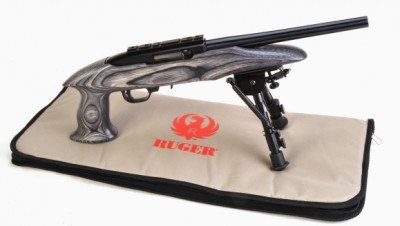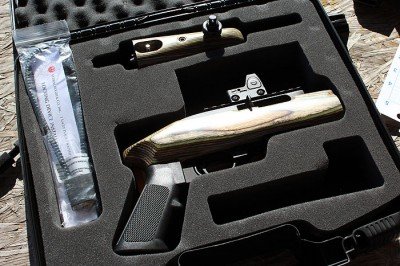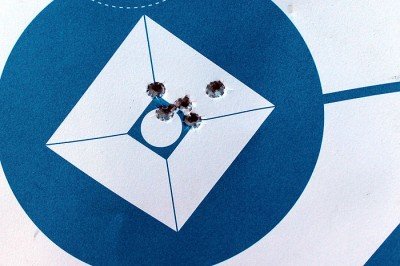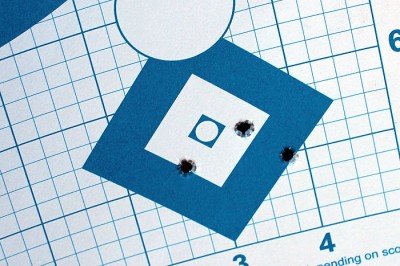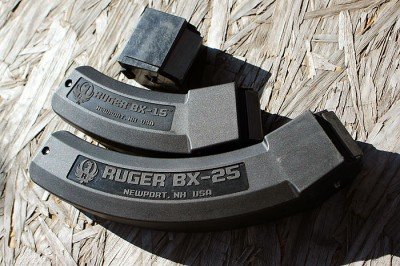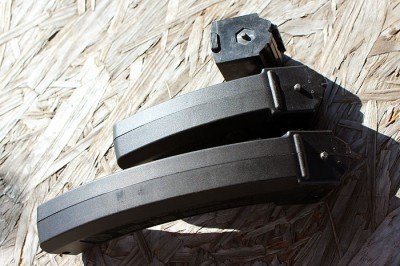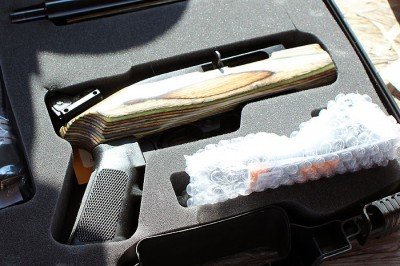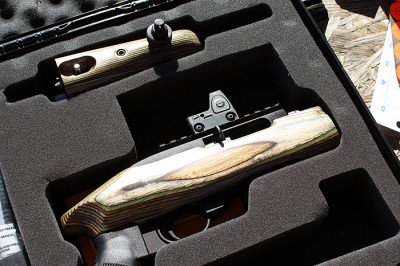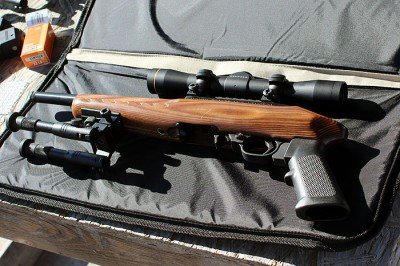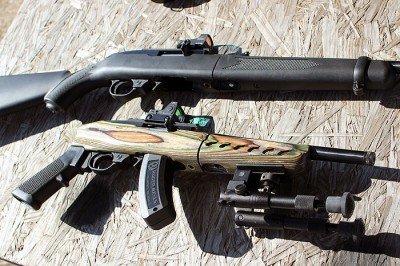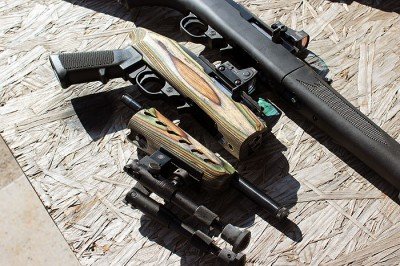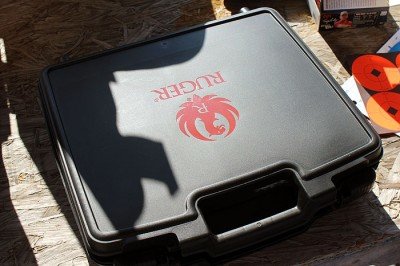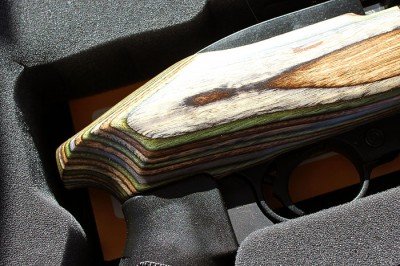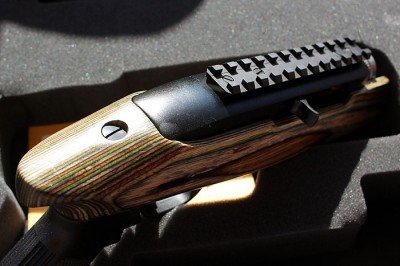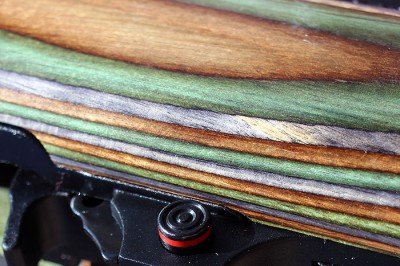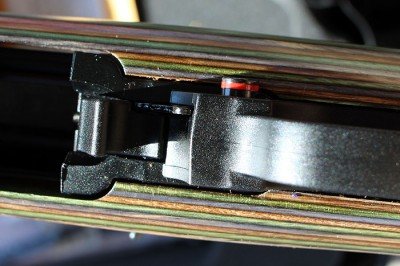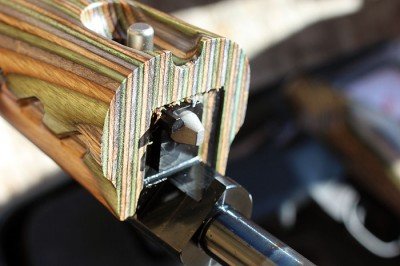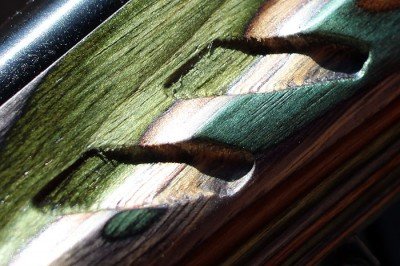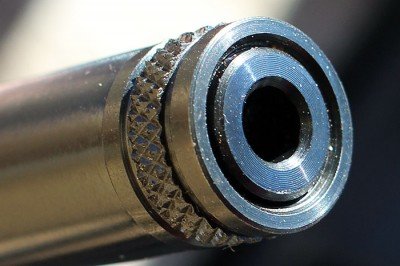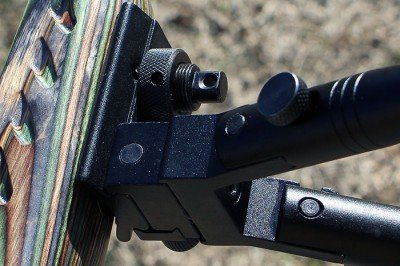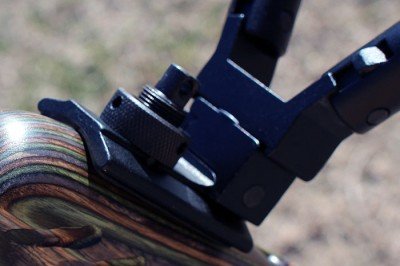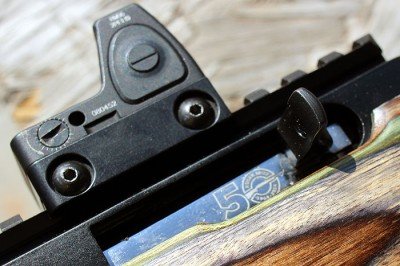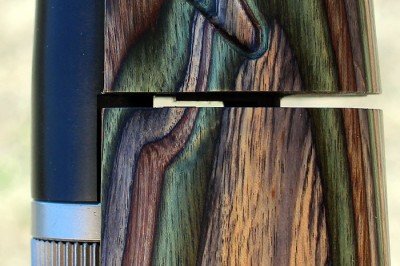
The SilencerCo Saker 556 with included wrenches for assembly / disassembly.
For a little baby bullet in a little baby cartridge, the .223 Remington / 5.56mm sure makes a lot of noise.
Unsuppressed, you can figure the noise level at about 165
decibels, varying, of course with rifle type, barrel length, etc. That’s
louder than a 12 gauge shotgun, a jet taking off or a jackhammer. It’s
way louder than the noise level you would experience sitting inside of a speaker box at a Def Leppard concert. Really, I checked.
When you mount a SilencerCo Saker 556 to an AR rifle, you
can expect the noise level to decrease to somewhere around 132 decibels.
That doesn’t sound like a lot of progress from 165 decibels, so you
have to remember that decibels operate on a logarithmic scale. Without
getting too geeky here, you can think of that 33 decibel increase
(unsuppressed vs. suppressed) in terms of being over eight times as loud
as the human ear perceives volume. Bottom line? Using a silencer on an
AR rifle is a big deal. Safety for the ears is a primary concern as a
single shot at 140 dB, or more, will permanently damage your hearing.
Repeated exposure to lower decibel noises will also cause
hearing damage, so wear protection always – even when using a suppressor
like this one.

Use of a suppressor makes all the difference with an AR-type rifle.
The SilencerCo Saker 556 is the original family
member. Now there is a Saker 762 and Saker K model, also for 5.56mm,
which offers a smaller and lighter package with slightly less sound
reduction capability. This model is not designed to be taken completely
apart, nor will you need to do that. Baffles are made from something
called Stellite, whatever that is, which is apparently 30% stronger than
Inconel, whatever that is. The net net of the fancy metal names is that
you don’t have to worry about cleaning the baffles. The end cap on the
front and the mount body do come off for cleaning and accessorizing, but
we’ll talk about that later.
Don’t get frustrated, get MAAD
On paper, the whole MAAD mount concept can be confusing.
In reality, it’s a piece of cake. I’ll take a crack at making sense of
how it works here.
The Saker body is the main part with the checker pattern
that you see in these photos. The ring at the back is the mount section.
To change the type of mount, you simply unscrew the mount section from
the main body. SilencerCo includes two wrench tools to facilitate this
process. Use some oil or anti-seize when attaching the mount to the body
to prevent galling. You may want to change mounts down the road, and
the hot and dirty conditions inside may make separation hard later.
The standard configuration of the Saker includes a
Trifecta Flash Hider and Trifecta MAAD mount. Just replace the muzzle
brake or flash hider on your rifle with the Trifecta, and now you have a
platform for quick attach and detach. To attach your Saker, set the
body and mount over the Trifecta Flash Hider. You’ll see that the bottom
of the Trifecta Flash Hider has a ridge or shelf that is roughly
rectangular in shape. This serves to orient the suppressor mount to the
flash hider in one direction only – the shelf fits into a mirror image
indentation in the bottom of the MAAD mount. There’s a good reason for
this. Detaching and reattaching the suppressor has no effect on change
in point of impact. To be clear, point of impact changes when you shoot
without the Saker. However, when you put it back on, it will shoot to
the same spot as before when previously mounted.
To complete attachment, twist the body to move interior
locking levers into position, and you’re good to go. You can do this
with one hand. Likewise, you can remove the Saker with one hand by
reversing the steps. Careful, this guy gets hot after some rounds.
You’ll also notice that the three prongs on the Trifecta Flash Hider
are all different lengths. This is by design and is intended to prevent
the flash hider prongs from singing like a tuning fork. I didn’t hear
Free Bird when
shooting, so I suppose the design works as intended. If you prefer a
muzzle brake, SilencerCo offers a MAAD compatible version of that too.

Note
the ridges on the Trifecta Flash Hider. The silencer can only mount one
way. This ensures that point of impact will not shift if you detach and
reattach the suppressor.

The
Trifecta MAAD mount installed on the Trifecta Flash Hider. Simply twist
the suppressor body and the MAAD mount locks onto the flash hider.
The neat thing about the MAAD system is that you can install
different mounting bases on the Saker body. You can order a direct
thread mount base that allows you to simply screw the silencer onto any
.223 / 5.56mm rifle that has a 1/2″x28 threaded barrel. Other optional
MAAD mounts include a 51T version for AAC gear, a Y-Mount for Yankee
Hill compatibility and an ASR mount for SilencerCo / SWR Specwar muzzle
brakes and flash hiders.
MAAD capping

The front cap unscrews to allow attachment of accessories.
You’ll notice that the front cap on the
Saker has indents. As you might guess, this means the front cap is
removable using the supplied wrench.
The first benefit of this approach is to protect your
investment from baffle strikes. The baffle strike is when something goes
wrong in the projectile hits the inside of the suppressor instead of
exiting cleanly through the fiery hole in the front. With many designs, a
baffle strike will pretty much wreck your silencer. Since the silencer
itself is ridiculously regulated that means you have to send the whole
thing back to the manufacturer to get it repaired or replaced with a new
unit with a new serial number. With the Saker design, odds are that a
baffle strike will simply knock the cap off the front. A non-regulated
spare part fixes that problem.
The second benefit is that you can use
different designs of and caps on the Saker. SilencerCo offers both flash
hider and standoff breaching / rebar cutting attachments.
Performance
To identify point of impact and/or
accuracy shifts, I chose three different hand loads of .223 Remington
that have been proven consistent performers out of my Smith & Wesson
M&P15 VTAC test rifle. Two were 77 grain loads and the third a 55
grain load, all using Sierra Matchking projectiles.
For each load, I fired groups with the
rifle’s “before” configuration of only a Surefire muzzle brake. I then
fired the exact same loads with the SilencerCo Saker 556 suppressor
installed. I put the target 50 yards down range to increase optical
precision and minimize issues related to my aging eyes. Using a 1-6.5x
Bushnell Tactical Elite scope, I was confident in my ability to hold
each shot at the exact same point of aim and minimize aiming error.
With all three loads, I detected a point
of impact shift downwards about ⅔ of an inch when the silencer was
installed. I couldn’t detect any lateral change in point of impact.
I couldn’t detect any change in accuracy
as measured by group size whether the silencer was on or off, so the
Saker appeared to have no impact, positive or negative, on accuracy.
I also checked velocity, suppressed and
unsuppressed, with all three loads using a Shooting Chrony Beta Master
chronograph placed 15 feet downrange. With all loads, average velocity
of multiple shots was about 15 feet per second higher when using the
Saker 556.
Since I had a Rock River Arms LAR-15 rifle handy that was
also a proven shooter, I mounted a second Trifecta Flash Hider on that
one and moved the Saker back and forth between rifles. With numerous
outings over a couple of months, I observed no changes in zero or point
of impact even though I attached and detached the Saker from each rifle a
dozen times or so.
Just the specs

The Trifecta MAAD Mount (installed) and the direct thread MAAD mount (right)
Caliber: 5.56
Weight: 18.0 ounces
Diameter: 1.500”
Length: 6.76”
Average Sound Level: 5.56 NATO – 132.2 dB
Finish: Black Oxide
Mount: Trifecta RS Flash Hider Mount
Optional mounts: 51 Tooth Mount, Direct Thread Mount, Y-Mount, Specwar Mount
Full Auto Rated
Lifetime warranty
MSRP: $1200 (with Trifecta flash hider mount)
Summing it up
I’m now officially spoiled. I’m not only keeping this silencer, I’m
also adding Trifecta Flash Hiders to every 5.56mm rifle I have so I can
just pop the Saker on whatever rifle I’m using. Plinking, competition or
home defense – no matter, all scenarios are better with the massive
reduction in sound and muzzle blast. Your rifle will get dirty faster,
but for the pleasurable experience of shooting with a silencer, I’ll
take that tradeoff.
Once you shoot an AR suppressed, you’ll never go back.



 Bolt Held Open on Last Round Fired
Bolt Held Open on Last Round Fired Flared and Beveled Magwell for Easy Reloading
Flared and Beveled Magwell for Easy Reloading Ambi Bolt Release
Ambi Bolt Release




 Convert to 9mm, .357SIG or .40S&W
Convert to 9mm, .357SIG or .40S&W 10-, 20- or 30-Round Magazines
10-, 20- or 30-Round Magazines Integral QD Sling Point
Integral QD Sling Point



 Conversion Kits for 9mm, .357SIG or .40S&W
Conversion Kits for 9mm, .357SIG or .40S&W SIG MPX Folding Stock
SIG MPX Folding Stock 10-, 20- or 30-Round Lancer® Magazines
10-, 20- or 30-Round Lancer® Magazines Segmented Vertical Forend Grip
Segmented Vertical Forend Grip Triple Mag Pouch & Single Mag Carrier
Triple Mag Pouch & Single Mag Carrier LE Carry Bag
LE Carry Bag SIG MPX Deployment Bag
SIG MPX Deployment Bag

















